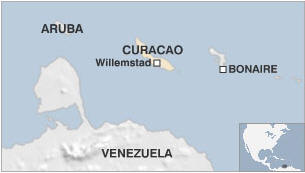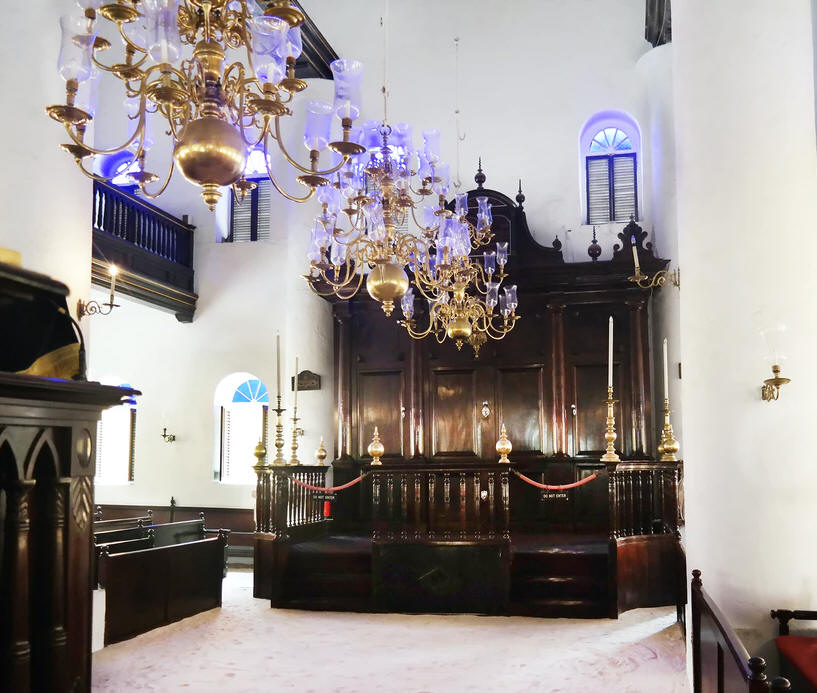


 |
 |
 |
||
| Curacao was conveniently located to be a market for supplying the Spanish colonies of Central America. The Coro Peninsula can be seen to the west of Curacao - a Moses Baruch Lousada was sent there by the Curacao Governor in 1720 on a salvage matter (ref 21 and 40). The Baruch Lousadas seem to have arrived in Curacao from both Barbados and Surinam at a similar time ie around 1685-90. | Interior of the Mikve Israel Synagogue | Mikve Israel Synagogue of Curacao consecrated in 1732 | ||
Curacao and the Baruch Lousadas
Curacao is a country of the Kingdom of the Netherlands. Starting in 1634 it developed into a major trading port through which the Dutch West India Company (WIC) supplied the Spanish American colonies. Examination of the records of WIC (ref 40) shows the close connection between the Jews of Curacao and those of Amsterdam - virtually all the Jewish merchants of Curacao had a senior male relative in Amsterdam. Some Jews arrived about 1651, but the first significant Jewish inflow was a group of 70 - mainly exiles from Dutch Brazil - headed by Isaac da Costa in 1659. Curacao has had a significant and continuous Jewish population from about 1651 until the present. During the War of the Spanish Succession 1701-14, many Sephardic merchants in the Caribbean had their trade with the Spanish colonies disrupted, though in Curacao the Dutch transit trade with the Spanish Caribbean continued. There was further movement from Barbados to Curacao in this period, and ref 123 p562 lists some Barbados Jews who applied to settle in Curacao. With its 1400 Jews in 1745, Curacao was the leading Jewish community in the Americas, a position it held for 150 years. In the mid-18th century the Jewish population was almost half the white population (ref 21 p133). In the later 1700s it became a dispersal point for Jews who settled all around the Caribbean and by the end of the 18th century, the dispersal of Curacao Jews around the Caribbean gathered pace and led to a slow decline in Jewish numbers in Curacao (ref 135). A 2017 impression of today's Curacao may be found here.
In ref 113 are listed 14 tombs of Baruh Lousadas and we note that without much difficulty all 14 can be fitted into our genealogical chart which links them with the Surinam Louzadas. In this chart can be seen a good deal of interchange between Curacao and Surinam, for many Curacao Baruch Lousadas lived in Surinam for a period. There was also a strong Barbados connection - for some decades after the Baruh Lousadas arrived in Barbados around 1659, members of the family moved to Curacao. Our chart identifies the Moses Baruch Lousada sent to Coro (see map), those Baruch Lousadas of Barbados origin, those Baruch Lousadas who came to Curacao from Surinam around the same time as did those from Barbados, and those Baruch Lousadas who re-established the Baruch Lousadas in Surinam. It also identifies the Baruch Lousadas who fulfilled community roles in Curacao (see note 4 below).
Many more details of the life of the Curacao Baruch Lousadas can be found in ref 40. The only parnassim (community elder) seems to have been David (probably the younger David) in 1746-7 (p788). Isaac was listed as a WIC taxpayer in 1707 and 1707 having a wife and 2 children (p766) whilst Moses (probably Moses the elder before his marriage to Sarah Lopez Henriques which occurred before 1715) was also listed having no wife or children (p766). Moses occupied the house of David Lopes Dias in 1715 (p772). The wife of Isaac at this time must have been his second wife (Esther da Motta whom he married before 1705) as he previously married his cousin Rebecca in London in 1696. The family was inevitably involved in the bitter conflicts in the community in the 1740s surrounding the hot-headed community leader da Sola (see note 1 below). Abraham was excommunicated for a period in 1748 for having supported Selomoh Ribeiro against da Sola in that he with others did not pay his resulting fine. Earlier there had been a dowry dispute (see note 1 below) and community members were required to affirm that they agreed to uphold the community's ketubah (marriage contracts) but David (in 1746 - p1028) for reasons unknown did not sign. Abraham owned the vessel Gloriosa in 1744 but sold it to Flores & Castro (p690). Later in 1759 he became a licensed broker (p759). He was listed as a family head in 1746 and 1769 (p1028) but his son Isaac was only so listed in 1746. Isaac (possibly the son of David #1528 - see note 3 below) in 1736 was listed as a taxpayer to the WIC though he was the smallest payer on the list (p108). David Baruch Louzada owned the Bloempot plantation in 1745-8 but after his death in 1747 his widow sold it with 3 slaves in 1748 for 7450 pesos; she however was listed as having 2 slaves in 1764-5 (p1028). This is clearly the David who died 25 Mar 1747 (ref 113 p527).
Notes:
1. In which the new widower Leao sought not to return half the Pereira dowry as was customary; the reluctant widower eventually lost his case - see ref 177 in which de Sola's behaviour is examined.
2. On TheSephardicDiaspora Facebook page on 9 Mar 2016 appeared the following advice (which we have slightly edited) on the extensive and extant Curacao Synagogue records: contact Mr Levy René David Levy Maduro but first consult refs 40 and 113. Once the person of interest is identified, he will search the archives for you, but will not allow you to enter them.
3. Amsterdam records show amongst the Den Haag Louzadas a Solomon who appears in Curacao in 1753 - he appears to have been the only Den Haag Louzada to use the Baruch pre-surname. Ref 199 records both Abraham and his son Isaac (then in Curacao) using Isaac Orobio de Castro as their Amsterdam consignee for the 1744 voyage of the vessel 'de Juffrouw Gesina'. Data from Fenneke Louzada-Scheltens shows that Isaac Orobio de Castro was a son-in-law of Rebecca Baruch Louzada (daughter of David #44), while 2 other children Rachel and Aaron Henriques Moron appear on the same list but using different consignees.
4. From ref 113 p57, we learn that 'Ishac Barugh Louzada' was Parnas de Hebrah (administrator of burials) in the Curacao Jewish community for the 1699-1700 Jewish year, whilst David Barugh Louzada in the 1732-3 Jewish year filled the same role. David (perhaps a grandson of the younger David via his son Jacob) married Rebecca de Abraham Sasso y Campanel on 22 May 1774 (p932) and she seems to have become the last of the ritual bathers in 1816 (ref 40 p89).